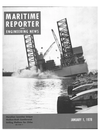
Page 36: of Maritime Reporter Magazine (January 1978)
Read this page in Pdf, Flash or Html5 edition of January 1978 Maritime Reporter Magazine
'SHIP DISMANTLING'
LEVIN METALS CORP. 1310 Canal Blvd.
Richmond, CA 94807 (San Francisco Bay Area)
Sources For
Diesel Gens.
Turbines
Evaporators
Condensers
Pumps
Reduction Gears
Motors AC/DC
Axial Fans
Boilers
Shafting
Propulsion Systems
MG Sets
Valves
Compressors
Anchors
Chain
Winches
Windlasses
Port Lights
Propellers
Deck Items
W/T Doors
Scuttles
Assorted
Shipboard
Spares
Contact:
Mr. Peter Mitchell
Marine Sales Department (415) 236-0606 Ext. 50, 51
For Your Next Navy Standard & Marine Coils
See Us!
Quality
Products
Listing foLMAC
COIL, INC.
Phone (509) 684 2597
COLVILLE. WASHINGTON 99114
SEMINAR ON SHIP OPERATIONS — Attendees at the Seminar on Ship Operation in Heavy
Weather, held recently at Webb Institute of Naval Architecture, Glen Cove, N.Y. 11542. Lec- tures and discussions covered the latest developments in shipboard instrumentation to assist in optimizing ship behavior at sea and in weather routing procedures to minimize delays due to rough seas. From left to right: (Front row) David Tein, American Bureau of Shipping;
Horton Lain, Hydronautics, Inc.; Soon I. Hong, J.J. Henry Co., Inc.; A. Erich Baitis, David
W. Taylor NSRDC; M.A. Blanchard, Edo Corp.; Richard J. Burke, SUNY Maritime College;
Dr. George Christoph, Sun Shipbuilding & Dry Dock Co. (Second row) John Dalzell, David- son Laboratory; Norman Stevenson, Fleet Numerical Weather Central (FNWC) ; Dr. Henry
Chen, M.I.T.; Dr. Dan Hoffman, Webb Institute; John Hayes, FNWC; Dr. Vincent Cardone,
City University of New York; Dr. Walter Maclean, NMRC, Kings Point; Robert Reid, Sperry
Marine Systems. (Third row) Prof. Edward V. Lewis, Webb Institute; William A. Silveria,
Ocean Routes, Inc.; Harvey C. Paige, Maritime Transportation Research Board; James Ware,
Department of Navy, Sealift Command; Susan M. Lee Bales, David W. Taylor NSRDC;
Wolfgang Reuter, NavSec; Lt. Mark D. Noll, U.S. Coast Guard; William H. Garzke Jr.,
Gibbs & Cox, Inc.; Rear Adm. Charles Payne, USN (ret.), Webb Institute. (Last row) Ed- ward Comstock, NavSec; Edward Duffy, NavSec; Don Ewing, U.S. Coast Guard; James W.
Wheaton, Teledyne Engineering Services; Peter Flemming, John J. McMullen Associates,
Inc.; Lt. Comdr. William Stark, U.S. Merchant Marine Academy, and Norman Cima, Ocean
Routes, Inc.
The Parcel Tanker Trades
The term parcel tanker has no precise meaning, but it is frequently applied to highly specialized ships designed to carry highly specialized liquid cargoes (which of- ten have severe hazards as regards toxicity, corrosiveness, inflammability, or a combina- tion of these, or which must be kept free from all contamination) in relatively small cargo lots, perhaps with a minimum of some 500 tons. In Study Number 58, a rather more liberal interpretation of the term par- cel tanker has been adopted, and all tankers of a greater sophistication than a conven- tional refined products carrier, and their
Diving and Marine Contractors • Explosives & Demolition • Underwater T.V. Unit • Ultra Sonic Testing rmp
Marine IServices, Inc.
Pier D, Berth 34
Long Beach, California 90802 213 437-7407 • Underwater Inspections • Salvage & Recovery • Underwater Welding & Cutting • SCAMP® Underwater Hull
Cleaning
Los Angeles San Diego Honolulu
Norfolk Houston San Francisco cargoes, have been included, subject to a minimum size of 10,000 dwt. The minimum size enables the analysis to concentrate on inter-regional deepsea trades. In many ways, this is the most fascinating sector of the tanker market, containing not only relatively simple ships, but also those embodying the most advanced technology for transporting and handling bulk liquid cargoes. However, there is increasing pressure for international standards to be applied to the transportation of all dangerous liquids by sea, and this pressure is having a profound influence on the design and operation of parcel tankers.
After introducing the concept of the par- cel tanker and explaining the nature of some of the legislative/regulatory pressures on the owners and operators of these ships, the study moves on to identify cargo types and to analyze the main inter-regional move- ments of chemicals, solvents and vegetable oil cargoes on a matrix basis for the years 1973 and 1975. A comprehensive fleet analy- sis follows (by ship type, size, age and ma- jor operator) which allows comparisons to be made between the balance of supply and demand of ships for the historical years an- alyzed. Finally, some projections are made of the likely developments in the chemical trades up to the early 1980s and of the po- tential future supply / demand balance for parcel tankers.
For a copy of Study No. 58, "The Parcel
Tanker Trades," write to HPD Shipping
Publications, 34 Brook Street, Mayfair,
London W1Y 2LL. Orders for overseas @
U.S. $75. 38 Maritime Reporter/Engineering News

 35
35

 37
37
